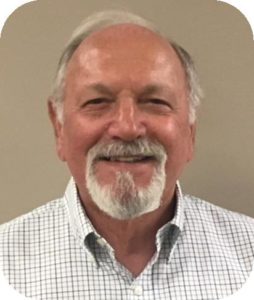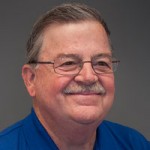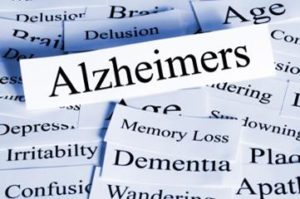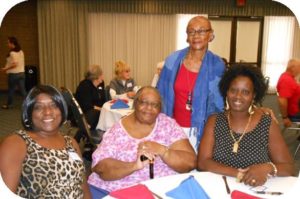June 2018
Honoring Yesterday – Protecting Tomorrow
Vol. 49, No. 6
June Calendar of Events
Thurs., June 7, 9:30am
RESDC Board of Directors Meeting
(New Location)
SDCERA, 2275 Rio Bonito Way, Suite 200
Thurs., June 14, 11:00am
Flag Day Luncheon
Ronald Reagan Community Center
195 E. Douglas Ave, El Cajon, CA 92020
Thurs., June 21, 9:00am
SDCERA Board of Retirement Meeting
2275 Rio Bonito Way, Suite 200

2018 Flag Day Luncheon
We’re going back to the Ronald Reagan Community Center in El Cajon on June 14
Would you like to catch up with fellow retirees, enjoy great food, and listen to wonderful entertainment? Join us at our annual Flag Day Luncheon on June 14 at the newly renovated Ronald Reagan Community Center in El Cajon.
More Information & Register →
President’s Message

By John J. McTighe
I’m looking forward to seeing many of you at our Flag Day Luncheon on June 14th at the Ronald Reagan Community Center in El Cajon. If you’ve never attended a Flag Day Luncheon before, make this a first for you. You’ll find good food, good friends, and good entertainment. As always, we’ll pay tribute to Old Glory and the history of this symbol of our country recognized throughout the world. (See page 8 to register for the Flag Day Luncheon.)
If you live in San Diego County and haven’t already voted by mail-in ballot, please make sure you go to your polling place to cast your ballot in the Primary Election on Tuesday, June 5th. Consult your sample ballot for your polling place or go online to the Registrar of Voters site at sdvote.com. It’s very important that all eligible voters cast their ballot. At this election we’ll be selecting the top two candidates to face off in November for the offices of Governor, Lieutenant Governor, and the state constitutional offices of Secretary of State, Controller, Attorney General, Insurance Commissioner, and Superintendent of Public Instruction. We’ll also be voting for the United States Senate seat currently held by Senator Dianne Feinstein and for everyone of our members of the House of Representatives and State Assembly. In addition, there are three State Senate (36th, 38th & 40th District) seats and the following local school district and City Council seats up for election:
- Two County Board of Education
- Three Grossmont-Cuyamaca Community College District
- Three San Diego Community College District
- Two San Diego Unified School District
- City of Chula Vista Councilmember and Mayor
- Three City of San Diego Councilmembers
At the County government level, there are two seats on the Board of Supervisors (Districts 4 and 5), the Assessor/Recorder/Clerk, District Attorney, Sheriff, and Treasurer/Tax Collector offices on the ballot. The incumbents for the four latter offices are all standing for re-election, but the two Supervisor races are wide open due to term limits forcing the retirement of Supervisor Ron Roberts and Supervisor Bill Horn at the end of their current terms in December of this year.
In addition to all the offices we are voting on, there are four local ballot measures (one in Chula Vista, two in National City, and one in County Service Area 113) and five statewide ballot measures.
By policy, RESDC does not endorse candidates for public office, but we do try to keep our members informed on issues that may directly affect them now or in the future. Since the members of the Board of Supervisors are responsible for overseeing the County’s finances and assuring the County continues to make the payments to the County pension fund, we reached out to all the candidates to solicit their responses to issues relevant to retirement with the intent to publish their responses on our website. I was disappointed that only candidate, Jim Desmond in District 5, returned the questionnaire. In fairness to all the other candidates we have not posted Mr. Desmond’s responses. After the primary election, when the field has been narrowed to just two candidates in each district, we will make personal contact with them to again solicit their responses and will publish those well in advance of the November General Election.
In late April, the County released a report entitled Alzheimer’s Disease and Related Dementia in San Diego County. The report is part of the ongoing Alzheimer’s Project that was started in 2014 by the County at the urging of then-Chairwoman Dianne Jacob. RESDC has been a supporter of the Alzheimer’s Project since its inception, and as a Live Well San Diego Partner, we continue to seek ways we can assist the County with this effort. Executive Director Mark Nanzer first wrote about the Alzheimer’s Project in The NETWORK in January 2015.
The County has adopted a definition of Alzheimer’s Disease and Related Dementia (ADRD) that is consistent with the Alzheimer’s Association and includes major causes of dementia such as Alzheimer’s Disease, frontotemporal dementia, and vascular dementia. Related forms of dementia include senility and mild cognitive impairment. Using that definition, major findings and forecasts are:
- In 2015: 84,405 San Diegans age 55 years and older were living with ADRD.
- By 2030: 115,000 San Diegans age 55 years and older will be living with ADRD, an increase of 36% from 2015.
Since most RESDC members are above age 55, the likelihood is that many of us, or someone we know, are now or will someday be affected by ADRD. On page 5, we have reprinted a list of the signs and symptoms of dementia taken from the County’s report. If you or a loved one is displaying any of these symptoms be sure to discuss them with a physician.
Next month I will provide additional facts and forecasts contained in this recent report. In the meantime, if you would like to read or download the report yourself, visit: www.SDHealthStatistics.com. ◾
The Plan’s In Good Shape
By Stan Coombs, Director
 AON Hewitt Investment Consulting Inc. recently told our San Diego County Board of Retirement, “The plan’s in good shape,” referring to the County Retirement System. But, how does that reconcile with media complaints about County retirement deficits. Can both be right?
AON Hewitt Investment Consulting Inc. recently told our San Diego County Board of Retirement, “The plan’s in good shape,” referring to the County Retirement System. But, how does that reconcile with media complaints about County retirement deficits. Can both be right?
“The Plan” is complicated. Lots of moving parts and interests involved; retirees, deferred members, active employees, taxpayers, even paid retirement system staffers and consultants. The plan’s funded with payroll deductions from active employees, annual contributions from the County, and the larger part, earnings from invested retirement funds. And, all this while the system pays out millions in monthly benefits that we count on. How are we doing?
Without diving in too deeply, the recent, June 2017 SDCERA Comprehensive Annual Financial Report said the system received $459,236,000 in County contributions that fiscal year, $113,213,000 in employee contributions, and $1,248,518,000 in investment earnings, totaling $1,820,967,000. Investments that year paid off well, a 12% return against a 7.25% long-range goal.
On the other hand, the system also paid out $664,662,000 in retirement and health benefits, $3,558,000 in various refunds, and $14,127,000 in administrative costs, totaling $682,347,000. We enjoyed a $1,138,620,000 net gain, increasing our retirement fund to $11.408 billion from the $10.269 billion reported the year before.
So far, so good. The County is obligated to ante-up its normal contributions required by the Board of Retirement each year, and is financially strong enough to do so. In the AON consultant’s words, “One of the things that. . .differentiates you from other public plans is your financial strength and capacity for cash flows to be stable.” Normal county payments are all but assured, and, of course, employee payroll contributions are deducted each payday, and submitted.
But, all that says nothing about whether the retirement fund has risen in lockstep with the system’s obligations to pay retiree benefits when they become due; whether we’re a fully funded system (?) What about the reliability of investment earnings, and all this talk about deficits?
The alleged deficits are real, to the tune of $3.37 billion through June 2017. Officially known as the Unfunded Actuarial Accrued Liability (UAAL), it means there isn’t enough money in the retirement fund, at this point, to cover all retirement benefits earned by members. The County retirement system is currently about 77% funded, compared to a reported average of about 71% for the 100 largest U.S. public retirement programs.
And, this happened how? Predictions of investment earnings aren’t absolutely dependable, and shortages create deficits. A blue-ribbon panel commissioned by the Society of Actuaries in 2014, opined that retirement funding “. . .assumptions are estimated to be realizable 50% of the time.” SDCERA has reported low-earning years occurred about three times per decade. They created much of the UAAL.
Happily, FY 2018 doesn’t seem to be one of those low earning years. SDCERA Chief Investment Officer, Stephen Sexauer, reports 7.8% earnings through March, exceeding the 7.25% goal for FY 2017-18, and increasing the fund to $12.4 billion. We’ll see what the fiscal years end brings (?)
Retirement funding deficits are also caused by reductions in the official long-term earnings goal, or assumption rate. Such reductions by the Board of Retirement mean lower future earnings are expected, requiring more funds from elsewhere. There have been five such rate reductions since 2004, lowering expectations from 8.5% to the current 7.25%. A .25% reduction increases the retirement deficit, and County costs about $40 million, we’re told. With every deficit event comes another scolding from the media, and fodder for public retirement critics.
Does this deficit predicament seriously threaten retirement benefits?
Financial risk to member benefits is real, but small. The UAAL isn’t ignored. Each deficit year “loss” is amortized and paid off by the County over 20 years. Retirement system assets may be insufficient to meet all system obligations now, but those obligations aren’t all due now, and won’t be for years, when members retire. There’s time to meet the UAAL payments.
How does this picture project into the future?
Seven days before AON’s declaration that, “The Plan’s in good shape,” County Retirement Actuary, Paul Angelo, presented a County UAAL payment schedule, through 2037. The projections were based on current UAAL levels, and assumed investment earnings would meet expectations every year. It showed the $343 million County payment due in 2017 gradually rising to about $415 million by 2023, and then irregularly falling to zero. The purpose of the chart was apparently to demonstrate cash flows. Few observers would expect 100% successful investing over 20 years (!)
It adds perspective to note the $343 million payment is about 6.4% of the County’s $5.4 billion FY 2016-17 annual budget.
It’s the reader’s call whether the San Diego County retirement plan is in good shape (?) ◾
Pension Facts
Be Happy, and Wary, in Retirement
Pension Facts at a Glance
$70,354
Average annual benefit payment for 2017 SDCERA retirees with 25-30 years of service credit.
By Chris Heiserman, Director
 It’s a fairly common belief that the retirement benefits of public workers who are already retired are guaranteed for life. Barring fiscal catastrophes like a monumental stock market meltdown or the rare occurrence of a local government bankruptcy, this is probably an accurate characterization of public retirees’ pensions in California.
It’s a fairly common belief that the retirement benefits of public workers who are already retired are guaranteed for life. Barring fiscal catastrophes like a monumental stock market meltdown or the rare occurrence of a local government bankruptcy, this is probably an accurate characterization of public retirees’ pensions in California.
This fortuitous circumstance for those already in their retirement years is bolstered by decades of legal precedent as well as the fact that the nefarious forces leading the charge to reduce workers’ retirement benefits are aiming their assault on current and future public employees. This is strategic in two ways: first, it sidesteps a costly and likely fruitless attempt to impair contractually vested benefits for retirees; and, second, they hope retirees will adopt an “I’ve got mine” mindset, consider themselves lucky with their secure, comfortable retirement and rest complacently on the sidelines as public pension critics try to undermine the retirement benefits of today’s and tomorrow’s public servants.
Unfortunately, there are naïve voices even in the defined benefit retirement plan community that consistently promote a “don’t worry, be happy” message. They urge retirees to live their lives to the fullest in their golden years, play golf, travel, enjoy the fruits of their labor and not spend one stressful minute being concerned about pension dollars. The overt pitch of these aficionados of pension paradise is that your retirement check will arrive every month like clockwork so if you want to, you can afford to put blinders on and forget about what’s happening in the rest of the world.
I guess that is an option. We could shrug off all the news about curtailing benefits for existing and future public workers. However, many of us do care and we try to keep providing good information about issues that in some ways affect all public employees, active and retired. We don’t want to allow public pension detractors to divide groups of public workers and dilute the strengths we have in common.
We are fortunate to be retired in a defined benefit system that is well managed and seemingly capable of delivering all the benefits promised. Still, pension reform fanatics are not wishing us well; they begrudge us our retirement benefits and are only leaving us alone now because it is easier to start their crusade by trying to erase pensions for future workers.
We are all taxpayers as well as consumers of government services. Most of us were proud of our work and considered our public careers more of a “calling” than just a job. I would like to think that young county librarian doing “story time” with my grandchild will continue to be a happy and dedicated county employee and not become preoccupied with looking for another position with better retirement benefits.
If public pension critics are successful, retirees from government service will face the same predicament as the majority of private sector retirees – not enough savings to maintain a decent quality of life, and heavy reliance on whatever Social Security benefits they may be eligible for. Families with minimal resources in retirement can become an economic burden on society. In that case, as public assistance rolls grow, we take a hit both as taxpayers and citizens, seeing more tax dollars going to help those less fortunate and fewer revenues available for basic services like parks, libraries and public safety.
We should continue enjoying the retirement we earned and helped pay for. However, we should also stay informed and pay attention to the shifting political winds when they begin to fill the sails of pirate ships bent on ransacking decent public worker retirement. We cannot allow public pension bashers to chip away at the benefits of current workers and bully the next generation of public employees. ◾
Recent Events
- California Pension Overhaul Bills Killed – A California state Senate committee has rejected a trio of pension overhaul bills that were intended to stem rising pension costs for the state. Rejected bills include a bill that would have prohibited a public retirement system that is less than 80% funded from providing cost-of-living adjustments (Senate Bill 1031); one that would have allowed local governments to leave CalPERS without paying large termination fees (SB 1032); and a third that would have allowed new state workers to opt for a 401(k) plan instead of a defined benefit pension (SB 1149). Although these bills won’t make it to the current legislative session, they could be brought back for consideration in future sessions.
- The County of San Diego vs. SDCERA Litigation – On April 17, 2018, the County of San Diego filed a Complaint for Declaratory Relief and Petition for Writ of Mandate against SDCERA concerning the implementation of Tier D, the County’s new defined benefit formula that will apply to new non-safety employees hired on or after July 1, 2018. Under Tier D, non-safety employees upon retirement would receive a pension amounting to 1.62% of their final annual salary for every year of county employment. This is a reduction from Tier C, which pays 2.3% per year. While the outcome of litigation is unknown at the time of our print deadline, stay tuned to The NETWORK and www.resdc.net, as we will continue to monitor the case and inform our membership with new developments. To learn more, visit: http://www.sdcera.org/news.htm and click on “Litigation”. ◾
 RESDC Day at the Padres
RESDC Day at the Padres
Tuesday, July 31, 2018 at 1:10 pm
Tickets Still Available!
San Diego Padres vs. San Francisco Giants
Ticket price is $48.00 per person. Petco Park is located at 100 Park Blvd., San Diego, 92101.
Tickets include a pre-game buffet with standard ballpark fare, served one hour before first pitch until one hour after first pitch, and soft drinks served from one hour before first pitch through the seventh inning.
 Registration: Registration forms and payment must be received in the RESDC office by Thursday, July 26. Tickets will be mailed approximately two weeks prior to the event date.
Registration: Registration forms and payment must be received in the RESDC office by Thursday, July 26. Tickets will be mailed approximately two weeks prior to the event date.
Register by Mail: Fill out the registration form, make a check payable to RESDC for $48 per person and mail both to RESDC, 8825 Aero Dr., Suite 205, San Diego, CA 92123.
Register Online: Click here and follow the steps. You will need to use the email associated with your member account. Click “Add guest” to add additional registrants for $48 each. To pay for yourself and guests, click “Pay Online” and pay with credit card.
Register by Phone: Call the RESDC Office at (619) 688-9229 during our hours of 9 am – 2 pm Mon-Fri.
For questions or assistance registering, contact us at (619) 688-9229 or resdc@resdc.net. ◾
 Special Event! You’re Invited!
Special Event! You’re Invited!
Tour and Presentation by San Diego Oasis
Grossmont Center
Tuesday, July 24, 1:30pm
RESDC invites our members and other interested parties to a tour and overview of the programs and classes offered by San Diego Oasis.
Oasis is dedicated to promoting healthy aging through lifelong learning, healthy lifestyles, and volunteer opportunities. If you haven’t had a chance to visit the Grossmont Center Oasis location in La Mesa, please join us to learn more about the wonderful programs offered county-wide by Oasis. We hope to see you there!
To learn more, visit www.SanDiegoOasis.org.
Date: Tuesday, July 24, 2018
Time: 1:30pm
Location: 5500 Grossmont Center Drive, Suite 228
La Mesa, CA 91942 ◾
 Early Signs and Symptoms of Dementia
Early Signs and Symptoms of Dementia
Alzheimer’s disease and related dementias affect individuals in different ways. However, there are ten early signs and symptoms, as described by the Alzheimer’s Association, that are typical of the disease. These are not meant to replace a consultation with a doctor, but rather serve as a tool to help identify potential symptoms. Individuals should see a doctor if they notice any of these signs.
- Memory loss that disrupts daily life.
This may include forgetting recently learned information or important dates and events, repeatedly asking for the same information, or relying on memory aides or family members for things they typically used to manage on their own.
- Challenges in planning or solving problems.
Individuals may have difficulty developing a plan and following through. They may also have trouble working with numbers, such as keeping track of monthly bills.
- Difficulty completing familiar tasks at home, at work, or at leisure.
Daily tasks, such as driving to a familiar place, may be difficult to complete.
- Confusion with time or places.
This may include losing track of dates or the passage of time. Individuals with Alzheimer’s disease may forget where they are or how they got there.
- Trouble understanding visual images and spatial relationships.
Individuals with Alzheimer’s disease may have trouble reading, judging distance, or determining color and contrast. They may also have difficulty with perception, such as passing a mirror and not recognizing their reflection.
- New problems with words in speaking or writing.
Following or joining a conversation may be difficult. Individuals with Alzheimer’s may also have problems with vocabulary, such as not being able to find or use the right words.
- Misplacing things and losing the ability to retrace steps.
This may also include placing things in unusual places.
- Decreased or poor judgment.
Examples include using poor judgment when handling money or paying less attention to daily tasks such as grooming and bathing.
- Withdrawal from work or social activities.
Individuals with Alzheimer’s disease may start to detach themselves from hobbies, social activities, work projects, or sports. They may also avoid being social because of the changes they are experiencing.
- Changes in mood and personality.
This may include becoming confused, suspicious, depressed, or fearful. Individuals with Alzheimer’s disease may also be easily upset, especially in places out of their comfort zone.
Source: County of San Diego, Health and Human Services Agency, Public Health Services, Community Health Statistics Unit, 2018 Alzheimer’s Disease and Related Dementias in San Diego County.
Alzheimer’s Association. 10 Early Signs and Symptoms of Alzheimer’s. https://alz.org/10-signs-symptoms-alzheimers-dementia.asp ◾

 RESDC Roundup #2
RESDC Roundup #2
July 24, 3:00pm
BJ’s Brewhouse and Restaurant
The first Roundup was a tremendous success! We hope you’ll join us for our second get together.
The Roundup provides an opportunity to catch up over libations and appetizers with RESDC leadership and fellow members. No reservation required (no host bar). Come meet with old friends and make some new ones!
Date: Tuesday, July 24, 2018
Time: 3:00pm to 4:30pm
Location: BJ’s Brewhouse and Restaurant, 5500 Grossmont Center Drive, La Mesa, 91942.
(BJ’s is directly across from Target, next to Casa De Pico.) ◾
 June 2018 RESDC Board Meeting
June 2018 RESDC Board Meeting
If you haven’t had the opportunity to attend a RESDC Board meeting, you are invited to join us for a special “off-site” meeting to be held at the headquarters of the San Diego County Employees Retirement Association (SDCERA). Come join us to learn more about the business of both RESDC and SDCERA.
When: Thursday, June 7, 9:30am
Where: SDCERA
2275 Rio Bonito Way
2nd Floor Board Room
San Diego, CA 92108-1685 ◾
 New California Laws for 2018
New California Laws for 2018
By Mike Sloan, CRCEA
This is a reprint of a recent California Retired County Employees Association newsletter article.
For someone to be truly safe, they must know the laws of the land, and when you live in California, keeping up with changes in the law can be a full-time job. In 2017 the legislature passed over 800 laws dealing with everything from broken parking meters to legalizing a drug.
Here are some of the laws which were passed last year. Most went into effect on January 1. For further information, you can “Google” new laws in California.
MARIJUANA – Now licensed dispensaries can legally sell recreational marijuana to adults 21 years and older. About four dozen dispensaries are licensed by the state to sell marijuana for recreational use, with many other retailers expected to receive licenses in 2018.
ILLEGAL TO SMOKE MARIJUANA WHILE DRIVING – The state updated its laws to keep up with new marijuana regulations, making it illegal to smoke or ingest pot while driving or riding in a car.
SANCTUARY STATE – Another significant state law bars local law enforcement officers from cooperating with the federal Immigration and Customs Enforcement agency on deportations, except in cases in which immigrants had been convicted of certain crimes. Officers will also be barred from asking about a person’s immigration status.
PEDESTRIAN CROSSWALK VIOLATIONS – Pedestrians will have more leeway when crossing the street, after the state did away with a Penal Code section that prohibited people from entering a cross-walk if the countdown signal had already started. Those out for a stroll now can enter the crosswalk during the countdown as long as they cross safely before it finishes. This is a law that few people knew about unless they had received a ticket.
REFINANCING A MORTGAGE – Refinancing your mortgage just got a little more expensive. The housing crunch is hitting Californians hard, and lawmakers responded this year with 15 housing bills meant to spur affordable housing development and rent subsidies. To pay for some of the housing relief programs, the state has added a fee of $75 to $225 on real estate transactions, such as refinancing.
MINIMUM WAGE INCREASE – The state’s minimum wage will increase by 50 cents to $11 an hour at workplaces with 26 or more employees and to $10.50 at smaller companies. The increase is part of a law passed two years ago to raise the minimum wage to $15 by 2023 for all workers.
EMPLOYERS CANNOT ASK ABOUT PAY AT PREVIOUS EMPLOYMENT – Prospective employers cannot ask how much you make at your current or previous job, a provision meant to ensure lower paid workers, who tend to be women and minorities, won’t have their salary history continue to keep them underpaid.
STATE COLLEGES TUITION FREE FOR THE FIRST YEAR – The first year of community college will be free in California for first-time students. However, there does not seem to be the funding for this program at this time.
NO CONCEALED WEAPONS ON SCHOOL GROUNDS – School district officials will no longer be able to decide whether teachers, and other employees with concealed weapon permits, will be allowed to bring their guns onto campus.
ALCOHOL RESTRICTIONS FOR UBER AND LYFT DRIVERS – Uber, Lyft, and other hired drivers will be held to a higher standard when it comes to drinking and driving. Those drivers cannot have a blood alcohol concentration level of 0.04 percent or more when a paying passenger is in their car. This is half the limit for those not providing for hire services (0.08).
HIGHER GAS TAXES AND VEHICLE REGISTRATION FEES – On January 1, the price of gasoline increased by 12 cents a gallon, and the cost of registering a vehicle will increase between $25 and $175 based on a car’s current value. (Note: An initiative to repeal the above law may be filed in 2018 – Carl DeMaio is leading an effort to place a constitutional amendment on the ballot that would repeal the tax and fee hikes, and prevent future increases without a statewide vote of approval.)
PET STORES MAY NOW ONLY SELL RESCUE ANIMALS – Pet stores in California will be allowed to sell only rescue and shelter dogs, cats and rabbits. The bill goes into effect January 1, 2019.
CREDIT CARD SURCHARGES AT BUSINESSES – A federal appeals court says California can’t prevent businesses from charging additional fees to customers who use credit cards. The 9th U.S. Circuit Court of Appeals ruled that a 1985 state law, which banned credit card surcharges, violated the businesses’ free speech rights.
DISABLED PERSON PARKING PLACARDS AND PLATES – This law includes requiring applicants to provide proof of true full name and birthdate. The law also will limit the number of replacement disabled person parking placards an applicant can request, without obtaining a medical certification, to four in two years.
ELECTIONS – Get ready for a new era of voting in California: Senate Bill 450, which passed in 2016, does away with neighborhood polling places and replaces them with elections conducted primarily by mail. It represents another effort to boost sagging voter participation. Under the new system, every registered voter will receive a mail ballot. Drop-off locations will be available up to four weeks before Election Day, and temporary regional “vote centers” will open 10 days ahead of time to register voters and accept ballots. Select counties are allowed to implement SB 450 in 2018 elections; all others, including San Diego County, are allowed to adopt SB 450 reforms in 2020. ◾
 Flag Day Luncheon 2018
Flag Day Luncheon 2018
Thursday, June 14, 11:00am
Ronald Reagan Community Center
We are pleased to invite you to our annual Flag Day Luncheon on June 14, 2018. This year we are returning to the newly renovated Ronald Reagan Community Center in El Cajon.
Our Flag Day Luncheon is a festive celebration commemorating the adoption of the flag of the United States. The event will kick off at 11:00 am with a social half-hour, followed at 11:30 am by a brief program led by RESDC President John McTighe. Entertainment will be provided by the California Note Catchers, a nonprofit women’s barbershop harmony chorus. We’ll enjoy a buffet style lunch at approximately 12:15 pm, with ham, roast turkey, rosemary potatoes, green beans almandine, salads, desserts, and beverages. This is an indoor event with ample free parking on both sides of the center.
 When: Thursday, June 14, 2018, 11:00 am
When: Thursday, June 14, 2018, 11:00 am
Where: Ronald Reagan Community Center,
195 E Douglas Ave, El Cajon, CA 92020
Cost: $12 per person
Registration: Registration forms and payment must be received in the RESDC office by Friday, June 8. Name badges and opportunity drawing tickets should be picked up at the check-in table at the luncheon. They will not be mailed.
Register by Mail: Fill out the registration form, make a check payable to RESDC for $12 per person and mail both to RESDC, 8825 Aero Dr., Suite 205, San Diego, CA 92123.
Register Online: Click here and follow the steps. You will need to use the email associated with your member account. Click “Add guest” to add additional registrants for $12 each. To pay for yourself and guests, click “Pay Online” and pay with credit card.
Register by Phone: Call the RESDC Office at (619) 688-9229 during our hours of 9 am – 2 pm Mon-Fri.
Directions to Ronald Reagan Community Center: Located one block south of E. Main Street, El Cajon, directly off Magnolia Ave. Take I-8 to Magnolia off-ramp, go south to E. Douglas and turn left.
For questions or assistance registering, contact us at (619) 688-9229 or resdc@resdc.net. ◾
Welcome New Members
Eleanor D. Agustin – SDCERA
Kimberly E. Arellanes – Public Defender
Lauren A. Chin – Health & Human Services
Carl W. Harry – General Services
Francine Howell* – County Counsel
Thomas P. Maurino – Superior Court
Janice A. Mazone* – Human Resources
Socorro M. Medina
Eva Restua – Child Support Services
Judith M. Revak
Myrna T. Yee – Sheriff
*Associate Member
The surviving Spouse of a member is eligible for RESDC membership. For enrollment assistance, please call: (866) 688-9229. ◾
NETWORK is the official monthly newsletter of the Retired Employees of San Diego County, Inc. (RESDC), a private non-profit organization.
The information printed in the NETWORK is believed to be from reliable sources. However, no responsibility is assumed by the NETWORK for inaccuracies contained herein.
Business and Inquiries: Business matters and address changes may be recorded on our voicemail at any time, call (866) 688-9229. Please spell your name so the correct member record can be located.
Retired Employees of San Diego County, Inc.
8825 Aero Drive, Suite 205 | San Diego, CA 92123
Office Hours: 9 a.m. to 2 p.m. Monday through Friday
TELEPHONE: (866) 688-9229 Toll Free
FAX: (619) 688-0766
E-MAIL: resdc@resdc.net


